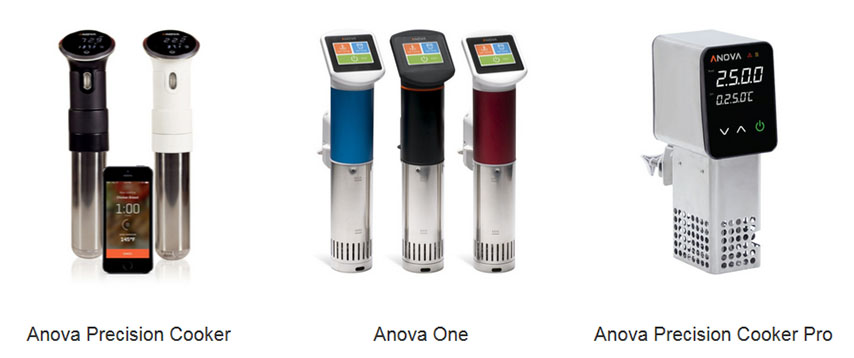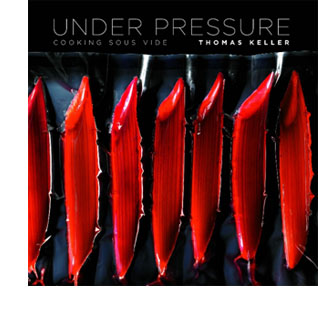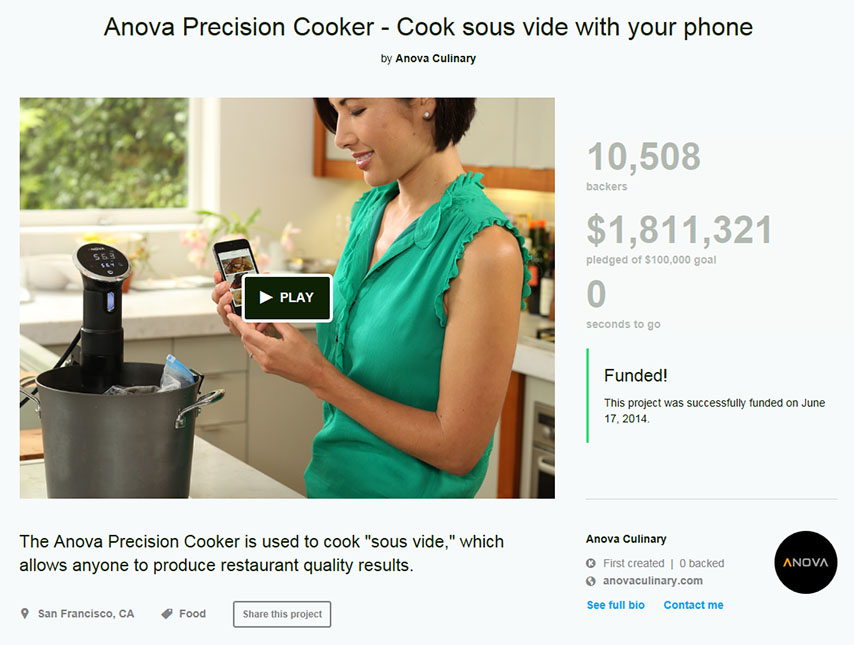As a second edition to my blog, I thought I would discuss the concepts of crowdsourcing and crowdfunding in more detail. But first, I would like to have some fun and share with you a recipe on how to cook the perfect steak (don’t worry, it all ties together). While everyone has their own preference on how a steak should be cooked, this method provides an essentially fail-safe way to get a consistent result every time and can be adapted to make perfect steaks for a large number of people.
Recipe
High Quality Steak – a thick cut of tenderloin, NY strip, ribeye or your favourite cut of Alberta Beef.
Salt
Pepper
Garlic or other seasoning (optional)
Olive oil
For the full meal, you can include your favorite sauce like béarnaise, peppercorn, wild mushroom or whatever you fancy. In my opinion, any steak goes well with mashed or roasted potatoes, asparagus or green beans, and of course your favorite bottle of Bordeaux, Cabernet or even a hearty Amarone.
You will also need a sous-vide cooker, and the topic of this blog is the model offered by Anova.

To be clear, I’m not getting any kind of kick-back or royalty from Anova for mentioning their product in this blog. This is just the brand of sous-vide cooker that I happened to buy after their Kickstarter crowdfunding campaign caught my eye as an interesting success story and a good real-life example of how crowdfunding works. Their product also has the feature of being able to be controlled wirelessly by an iPhone via their custom app. This is a neat feature, but the control dial and on/off switch on the unit itself seems to work just fine too.
What is a sous-vide cooker?
 For the foodies out there who are already well versed in this cooking method, you can skip ahead; but for anyone who isn’t familiar with the concept, please read on. A sous-vide cooker is basically a water bath and circulator that allows a chef to hold a sealed package of food at a precise temperature for hours of slow cooking. In the past these devices were quite expensive and generally a niche product that was found in the kitchen of a high-end restaurant. In recent years the precision control systems and technology involved have come down in price, and the interest from home users has brought a number of different models to market in the $150-$300 range (Anova has entry level units priced at $USD 179 and $USD 199, plus shipping). The theory behind this cooking method is that it keeps the food that you are cooking, like a steak for example, at a set temperature below boiling. You can keep a steak at medium rare temperature of 63 degrees Celsius (145 degrees Fahrenheit) – and it will not cook beyond this point. The middle of the steak will stay at medium rare for hours without over-cooking. With enough time at set temperature of medium rare or greater, the relatively low heat will have the effect of pasteurizing the meat and kill any essentially dangerous bacteria that could be resident in the meat. You can then remove the steaks and sear each side on a grill or in a very hot skillet for a short time and serve right away without wondering if you have reached the right internal temperature. There are other applications, like making perfect soft boiled eggs as well as interesting techniques for fish, vegetables and other meats.
For the foodies out there who are already well versed in this cooking method, you can skip ahead; but for anyone who isn’t familiar with the concept, please read on. A sous-vide cooker is basically a water bath and circulator that allows a chef to hold a sealed package of food at a precise temperature for hours of slow cooking. In the past these devices were quite expensive and generally a niche product that was found in the kitchen of a high-end restaurant. In recent years the precision control systems and technology involved have come down in price, and the interest from home users has brought a number of different models to market in the $150-$300 range (Anova has entry level units priced at $USD 179 and $USD 199, plus shipping). The theory behind this cooking method is that it keeps the food that you are cooking, like a steak for example, at a set temperature below boiling. You can keep a steak at medium rare temperature of 63 degrees Celsius (145 degrees Fahrenheit) – and it will not cook beyond this point. The middle of the steak will stay at medium rare for hours without over-cooking. With enough time at set temperature of medium rare or greater, the relatively low heat will have the effect of pasteurizing the meat and kill any essentially dangerous bacteria that could be resident in the meat. You can then remove the steaks and sear each side on a grill or in a very hot skillet for a short time and serve right away without wondering if you have reached the right internal temperature. There are other applications, like making perfect soft boiled eggs as well as interesting techniques for fish, vegetables and other meats.
(A great cookbook on the sous-vide cooking technique is Thomas Keller’s Under Pressure)
How did this all start? What on earth is a Kickstarter or crowdfunding campaign?
Anova was a company that started as a crowdfunded idea and managed to raise over $1.8 Million dollars in a few months to get their company started. The campaign involved pitching their idea to the ‘crowd’, or basically putting it on the internet. The websites ‘Kickstarter’ and ‘Indiegogo’ are two of the best known crowdfunding websites and they act as a clearinghouse for ideas to get presented to the world in a more organized form. Many of the ideas are art projects, books, movies, and music. Consumer products and inventions are actually less of a focus for Kickstarter, but they do accept them when they see merit. Kickstarter does an initial vetting of the ideas that are proposed and then approves the project to be posted on their website. The person seeking the funding will need a fairly polished video or pitch on the website in order to capture the imagination of the public. Getting people interested in the idea is one thing, but getting them to open their wallets and actually fund a project is another. The group seeking funding will often offer some enticement for funding at a higher level, for example a first edition and signed copy of the artist’s album that is being funded in exchange for a higher level of funding. For a consumer product, the funder might get first access to the final product that is eventually made. This method of funding can be an incredibly successful way for the start-up to raise money as they gain a captive audience of fans for an artist, or willing buyers in the case of a consumer product. They may also get some publicity and some validation that the idea has merit and people will actually buy it or be interested in it.

At the moment, any funding is essentially just a donation from a benevolent individual who wants to see a project succeed. Or it could be set up as the pre-purchase of a specific product or piece of creative work. The securities laws in the U.S. and Canada currently make it difficult for companies to offer equity stakes or share ownerships in the business that is looking for funding, but this is currently being reviewed and could be an interesting change to how start-up companies get funded. This is a case of the laws not really keeping up with the reality of the disruptive changes in the marketplace. Why should start-up investment opportunities be limited to so called ‘accredited investors’ who have over $1million of investable capital? Is someone really taking a big risk if they put a few hundred dollars (or an amount that won’t do much damage if it goes to zero) toward a start-up idea that they are passionate about seeing succeed? It will be interesting to see how the securities laws develop in this area in the coming years.
The other outcome, and this happens more often than not, is that the Kickstarter campaign results in a failed funding attempt where the project doesn’t meet the funding goal. In this case, the artist or entrepreneur will gain valuable experience and feedback on how the product could be improved, or come to the realization that their idea or product doesn’t have enough critical mass and just wasn’t meant to be. In any event, they won’t have risked their life savings to launch their project. If people commit to funding a project that doesn’t meet the funding goal, they simply don’t pay anything.
On June 17th, 2014, Anova’s Kickstarter campaign closed at just over $1.8 million and the company was funded and on their way. In their case, they were able to raise a significant amount of non-dilutive capital to start their business. A few months later they had successfully launched their product from design, manufacturing, and eventually to online sales. I ordered one online and had it under my tree as a gift to my wife in time for Christmas (admittedly, it was as much a gadget for me to play with as a gift for her, but I’m sure that she’s figured that out already).
Crowdfunding is a new and potentially disruptive way for companies to raise money and get a start. It allows anyone with an idea to present it to the world and get the funding to make it happen. The reality of the business world is that now the competition to a major business with an established market isn’t necessarily their existing direct competitors in their market; it can now be a couple of people in their basement working on something new and innovative with the tools to launch it to the world in a rapidly scalable way.
Another example of this phenomenon is the successful website ‘Quirky’. Quirky is an invention-focused website where an inventor can propose an idea to the ‘Quirky’ community and have the community of inventors and tinkerers help develop it further. If the idea gets enough traction, Quirky will take over and do the legwork of prototyping, testing, manufacturing, marketing, and eventually selling the product on their website. The inventor gets approximately a 10% cut of the sales, and others in the ‘Quirky’ community who have helped develop the project gain points that will earn a cut of the sales. From the inventor’s standpoint, it allows them to get their idea to market and stay within their area of expertise (ie: inventing things), and leaves the final prototyping, development, manufacturing, marketing, sales, shipping, fulfillment, returns, management, etc., to a group that is already set up and well organized to do this. Is a 10% cut a reasonable amount for the original inventor to get of the whole deal? Probably, when you consider that all of the funding and building an organization to accomplish all of the things that need to happen to bring a product to market are taken care of with basically no risk to the original inventor. An inventor getting 10% of a successful product launch is obviously much better than keeping 100% of an idea that sits on a shelf and never makes it into people’s hands.
A recent example of the business world taking advantage of this concept is General Electric’s partnership with Quirky on certain consumer products. It appears that they have realized that any organization has its limits, and the best ideas don’t always come from within their own organization. For certain product areas, they can bring new and more innovative ideas to market cheaper and more quickly than they can from within their own organization.
Back to the recipe
Set sous vide cooker to medium rare or 63C/145F (or whatever your preference of doneness). Season the meat with salt, pepper, and a good quality olive oil. You can also add a bit of garlic or other seasoning if you want the steak to absorb any other flavours during the sous-vide process. Seal the meat in a vacuum sealed envelope (if you don’t have a vacuum sealer, you can probably fake it with a Ziploc bag by squeezing all of the air out, but be sure to remove all of the air as any air bubbles will interfere with the heat transfer). Immerse the sealed meat in the cooker for at least 1 hour. The drawback of this process is that, although the final cooking process is very quick, it does take some advance planning and set-up time. You can keep the steaks in the water bath at the set temperature for several hours and simply remove them when they are ready to grill or sear. If you leave a fatty steak in the water bath for longer, the fat in the meat will start to dissolve and tenderize, resulting in an even more tender steak as the final outcome. This is a great way to cook steaks for a crowd at a dinner party and not have to worry about timing or messing things up if you have too many to fit on your grill at once. When you are ready for the final step, you will need to remove the steaks from their sealed package and dry them off to remove any moisture. You can re-apply a light coat of olive oil to help with the final searing on the grill or cast iron skillet. When everything else is ready to go for your meal, you simply have to sear the outsides of the steaks for 30 seconds to 1 minute on each side, let them rest for a few minutes and serve. There is no fussing around with meat thermometers or poking them with your finger to see if they still feel squishy. As long as you don’t sear the steaks for too long on each side, you should end up with a perfect outcome every time.
Bon appetit!